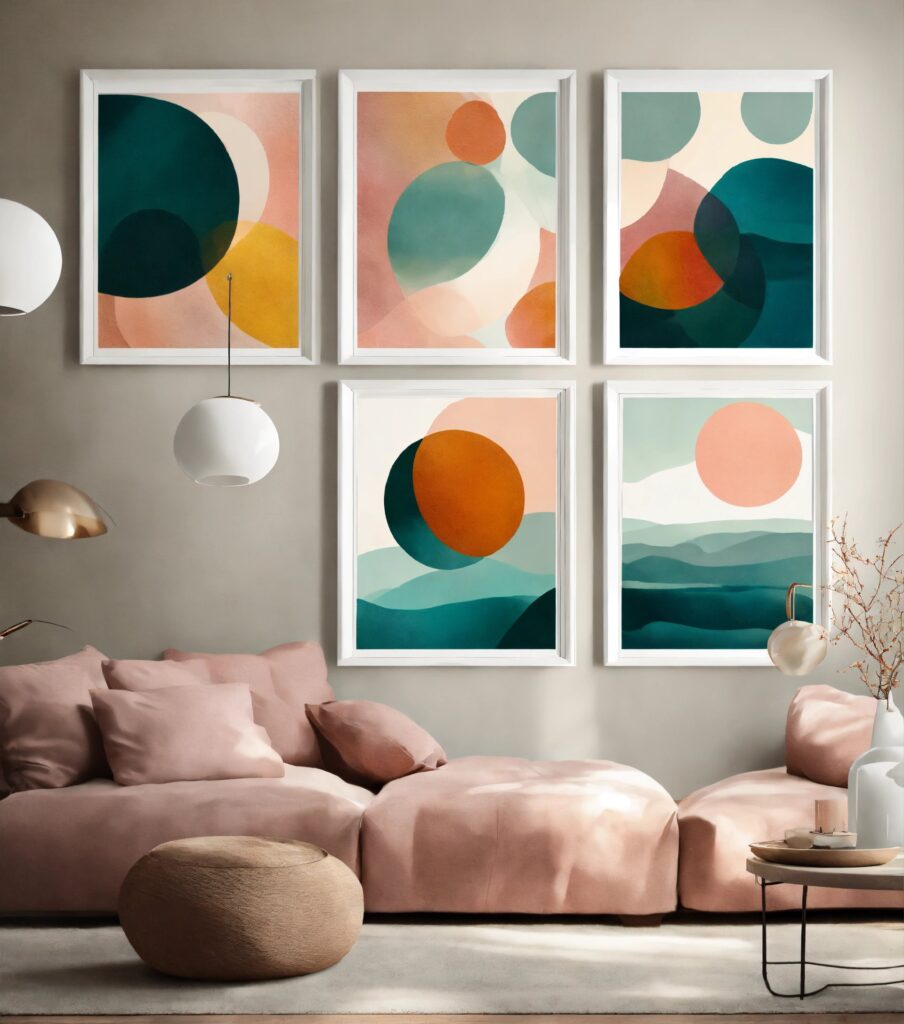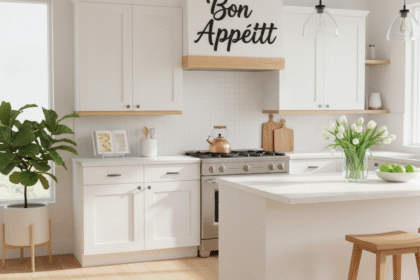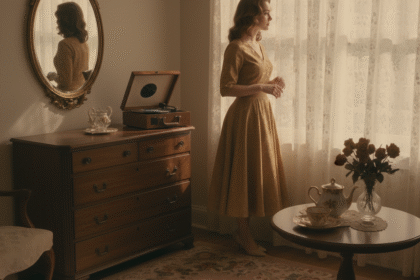Having a gallery wall in your home decor makes your space look more luxurious and gives it an artistic touch. To create a visually attractive gallery wall you need to mix styles perfectly this includes choosing the styles, frames, and the art piece itself so this article will be your full guide on how to mix and match various styles for an eye-attractive gallery wall.
Table of Contents
Understanding Different Art Styles
| Art Style | Description | Best For | Examples |
|---|---|---|---|
| Abstract | Uses colors, shapes, and forms to create non-representational art. | Creating bold, contemporary focal points in your gallery wall. | Geometric shapes, splashes of color. |
| Realism | Depicts subjects as they appear in real life, with detailed accuracy. | Bringing a sense of familiarity or nature into the space. | Portraits, landscapes, animals. |
| Minimalism | Focuses on simplicity, with clean lines and limited color. | Enhancing modern, clean interior spaces. | Simple geometric forms, monochrome works. |
| Pop Art | Inspired by popular culture, using bright colors and recognizable imagery. | Adding a fun, vibrant touch to your gallery wall. | Prints of celebrities, comic-style art. |
| Vintage/Classic | Traditional art that has historical or antique qualities. | Creating timeless, elegant spaces with a sense of history. | Black-and-white photography, classic paintings. |
Importance of Variety
Adding a variety of art to your gallery wall makes it look special and gorgeous. Every art piece has a special look and feels that adds to the mood of the room. Try mixing up types like abstract, realistic, and pop art. This mix brings a whole palette of colors, shapes, and ideas that catch the eye and impress your guests. It’s not just visually appealing, but it’s also about showing your tastes, and experiences. A carefully put together gallery wall with varied styles has depth, and character, and tells your story. It turns a simple art collection into a story about you. This thoughtful mix creates a space that’s lively, and welcoming and makes your gallery wall the special piece of your home decor.
Choosing a Theme or Focal Point

Setting a main idea for your gallery wall is key to making it look nice and organized. The conception can be based on certain colors, themes, or your favorite artist or time period. Like, choosing simple colors can give a chill vibe, whereas strong colors can make your space special. Choosing a theme like nature, family, or abstract shapes can bring out different emotions and create the room’s feel. Besides, featuring art from a certain artist or era lets you really dive into that style in your collection.
When you’re creating your gallery wall you need to Think about a focal piece method. Spot one or two pieces that align with your preferences. Make sure these pieces are bolder or bigger to grab focus. Positioning these standouts at the center or eye level forms a good base for the rest of your work. If you’re mixing styles, ensure a good balance to keep things smooth.
Mixing Frame Styles and Sizes
Crafting a unique gallery wall partially depends on your frame selection. It can make a huge difference to your gallery’s overall look. Choose from different frame materials such as wood, metal, or plastic. Each one brings its own touch and personality to the wall display. Mixing the colors of the frames using black, white, or even gold creates visual excitement and depth. This lets each piece stand out, while also creating a balanced look. Moreover, to make things more interesting, mix and match frame widths. Play with thick and thin frames. This not only adds layers but also initiates a fun mix of shapes, elevating your wall design to another level.
Mix up frame sizes, from little ones to big ones, to keep the display fun and interesting. Usually, bigger pieces are put in the middle or where people can see them easily to catch the eye. Next, position smaller ones around them to make a balanced picture. This staging effect guides the eye across the wall, appreciating each art piece’s special touch.
Creating Balance and Cohesion
The key to making your gallery wall cohesive and balanced hinges on having a steady color scheme. Picking colors that either match or conflict with your various artworks can bring a sense of unity to your display. Suppose you opt for a primary color for your centerpiece art, smaller pieces can echo that color to bring harmony. Striking a balance between bold and quiet pieces is crucial too; strategically placing bright, attention-grabbing art next to subdued ones can keep one from overshadowing the other. This approach raises the entire visual appeal of the wall and keeps a consistent theme throughout.
Think about the concept of visual flow when you organize your artwork. It directs the viewer’s eye over your display. To achieve this, we can use clever positioning, mix up the heights, or use smart spacing. You should also think about if you want an equal or unequal layout. An equal design brings order and balance, great for those who like things neat and tidy. On the other hand, an unequal design brings creativity and energy, making the gallery wall feel lively and spontaneous. In the end, choosing betwen equal and unequal should mirror your style and the feeling you want to bring to the space.
Mixing Mediums for Added Interest
Adding diverse types of art to your gallery wall can make it visually striking and interesting. Blend flat pieces like paintings and photos with 3D items such as sculptures or shadow boxes. This way, you can have a vibrant, exciting display. By mixing these mediums, you get different textures and shapes, making the wall eye-catching. Think about making your gallery wall meaningful to you by including family photos or unique items with emotional significance. Adding these personal elements not only adds a unique touch to your collection but also tells your story, making your wall art truly special.
Arranging Your Gallery Wall
Setting up your art wall requires some thought. Start with the biggest or most attention-grabbing items. Let these be your centerpieces. From there, shape the rest of the space. This way, the striking pieces get their much-needed spotlight. If yourWondering how to try out different designs without making lasting changes just use stencils or tape lines on the wall. This lets you envision how every item pairs up. Plus, it’s easy to switch things around until you spot that perfectly balanced, pleasing setup.
Remember that spacing matters. Keep your art pieces equally distant. This gives a neat, tidy look but keeps it flowing nicely. Usually, a gap of 2 to 4 inches between frames works well. It depends on the art size and your style goal. Think about how high to hang artwork. Eye level is ideal, generally 57 to 60 inches from the floor. This gives the best viewing comfort. If you are planning to place art over furniture like couches or tablesLeave about 6 to 12 inches from furniture top to art bottom. Plan your layout and spacing carefully. This way, you’ll achieve a harmonious, welcoming gallery wall.
Final Touches: Lighting and Accessories
Boosting your gallery wall’s look involves focusing on lights and accessories. Lights are key; they spotlight your art pieces, showcasing their character and hues. Think about putting in ceiling lights, wall lamps, or dedicated art lights. These direct light onto your art, adding heat and highlighting particulars. Besides lighting, it can help to add matching add-ons like little green plants, mirrors, or fancy clocks. Plants can add a natural and fresh vibe. Mirrors can make the place look bigger and bounce light, increasing depth.
Conclusion
Making an eye-catching wall gallery needs a blend of different designs, colors, and special details that show your personal style. Mix up various types of art, picture frames, and materials to give depth and personality. This turns a regular set of items into an exciting display. Having a main idea or main item helps you pick the pieces. Placing them thoughtfully ensures everything ties together. Remember, lights and extras enhance the display and set a friendly mood. Enjoy the creative journey, and make your gallery wall a mirror of your individuality.




